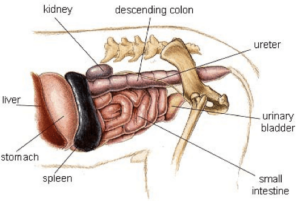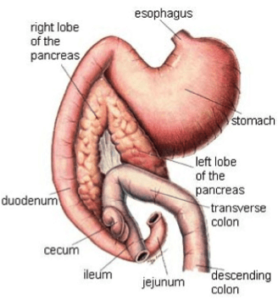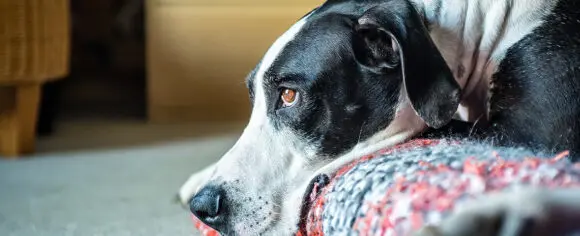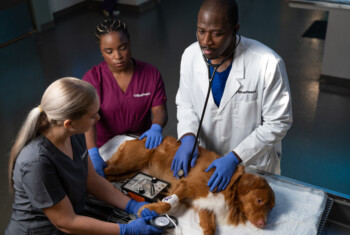Megacolon: Causes, diagnosis and treatment.
Megacolon is a disease of the colon (large intestine), which results in chronic constipation. There are two forms of megacolon: congenital and acquired.
Anatomy.
The gastrointestinal tract consists of a tube that runs from the mouth to the anus. Its function is to digest food and absorb nutrients into the body. The stomach is a dilated part of the GI tract that produces acids, which help with initial breakdown of proteins.

Photo courtesy of Hill’s Pet Nutrition
The small intestine extends from the stomach to the colon and serves to further break down food into absorbable nutrients. The colon is the reservoir for stool and serves as a water absorber; it is also the site for production of certain vitamins by bacteria. The colon has a larger diameter than the small intestine. The intestinal wall consists of a layer of muscle that propels feces out of the body during bowel movements. Small collections of nerves called Auerbach’s complexes are located within the muscle layer that stimulates the muscle to contract.
Causes of megacolon.
The congenital form is an abnormality of the colon seen at birth. These patients may lack the Auerbach’s complexes in the colon. The acquired form is the more common of the two. The most common acquired form is known as idiopathic, which means the cause of the disease is undetermined.
Potential causes may be related to the cat’s diet or environmental factors. A dirty litter box may result in refusal of the cat to have bowel movements on a regular basis, which eventually stretches the colon. Ingested foreign bodies such as bones may become impacted in the colon, and if not treated early on, chronic distention of the colon results in permanent damage to the muscle of the intestine.
Other diseases that could potentially lead to megacolon are those that narrow the rectum or anus resulting in difficulty passing stool. Examples include tumors within the pelvic canal or within the colon, anal sac abscesses or disease, and fractures that have narrowed the pelvic canal. Manx cats are prone to spinal cord deformities that may cause megacolon. Damage to the nerves from an injury may also affect the motility of the colon.
Signs and diagnosis.
Megacolon most commonly occurs in middle-aged, male, domestic shorthair cats. Stools may appear smaller than normal or be absent during episodes of constipation. Usually, affected cats pass a large amount of dry and hard stool one to three times per week. Other symptoms include decreased appetite, lethargy, weight loss, dehydration, abdominal pain, straining to defecate, vomiting and anemia.

Photo courtesy of Hill’s Pet Nutrition
The diagnosis of megacolon is based on clinical history and physical examination findings of a very distended colon with feces. A simple digital rectal examination will rule out masses or an obstruction within the pelvic canal that may be causing the megacolon.
Abdominal X-rays are used to confirm the presence of a colon distended with feces and to rule out other diseases, such as a malformed pelvis or a tumor within the abdomen or colon.
Abdominal ultrasound and colonoscopy are other diagnostics that are less frequently performed but may provide necessary information to diagnose an underlying cause of megacolon.
Because megacolon in kittens may be caused by a malfunctioning thyroid gland, a blood test may be recommended in these patients. Blood testing such as a complete blood count, chemistry profile and urinalysis are done prior to surgery to ensure that your companion can be safely anesthetized.
Treatment.
Medical management should always be attempted first unless there is an underlying problem that is causing the megacolon. If the patient is dehydrated, fluids may be administered under the skin or intravenously.
Your cat may need to be intermittently hospitalized to have enemas administered and potentially to have the stool manually removed from the colon under general anesthesia.
Laxatives or lubricating agents are useful to soften stools for easier bowel movements. A high fiber diet is recommended, which will keep the stools softer. Natural laxatives such as pumpkin can be added to the diet. Cisapride may also be prescribed to help improve the motility of the colon for more effective bowel movements.
Surgical treatment is recommended only in patients that require frequent trips to the hospital to have stool removed from the colon. During the procedure, an incision will be made into the abdomen to allow the surgeon to examine the internal organs. The colon is removed and the small intestine is surgically connected to the rectum.
While in our hospital, your companion will continue to receive intravenous fluids, electrolytes and in some cases plasma or an artificial plasma product called hetastarch.
Your companion will be carefully monitored in the intensive care and will be given narcotics to ensure a pain-free recovery. Most patients that have the colon removed can go home the day after surgery.


